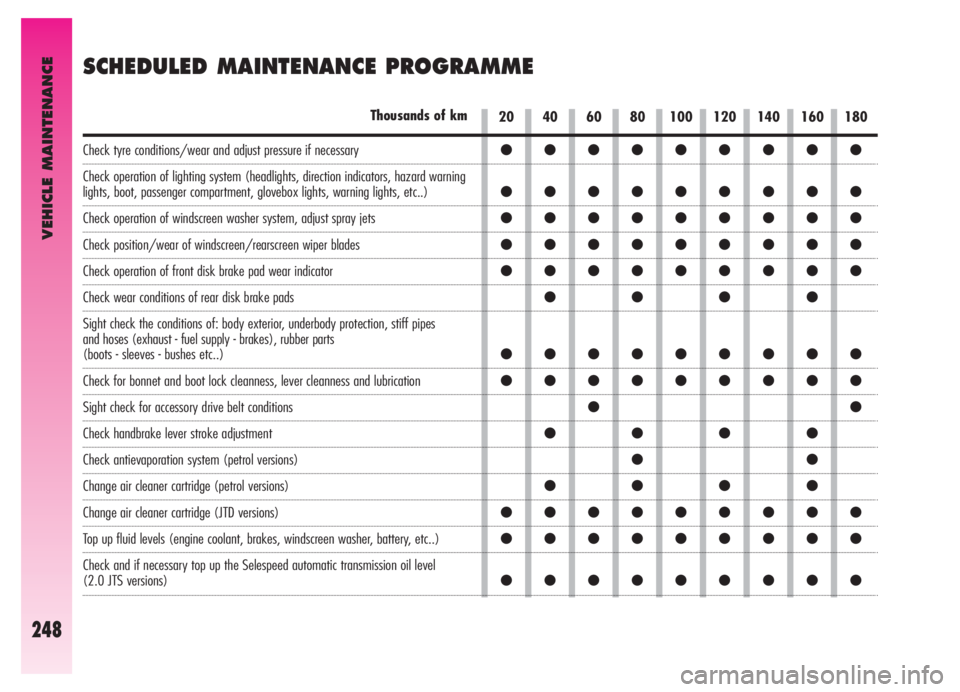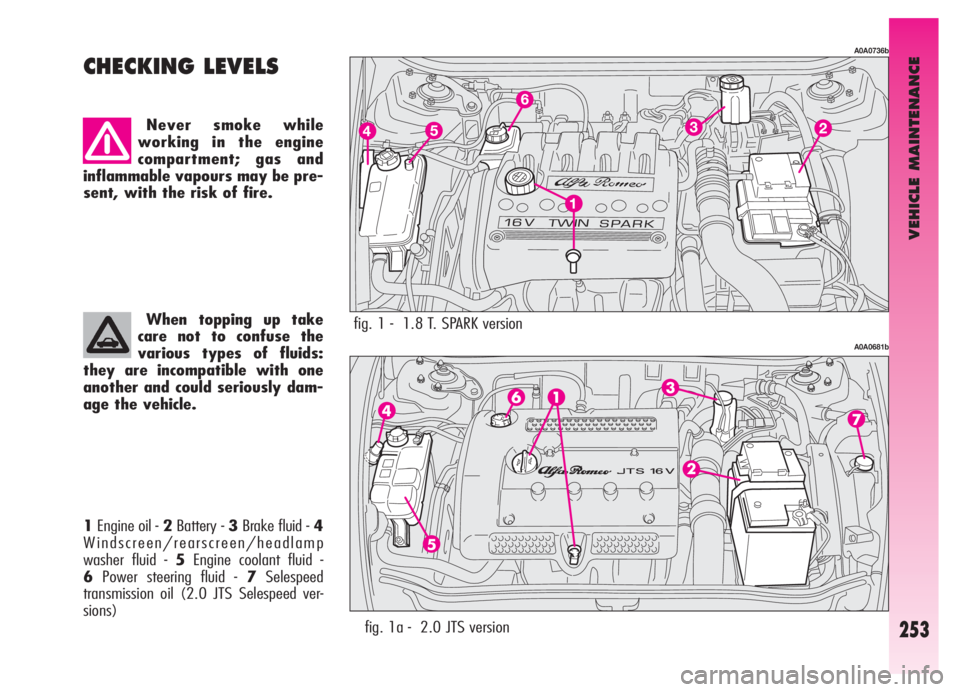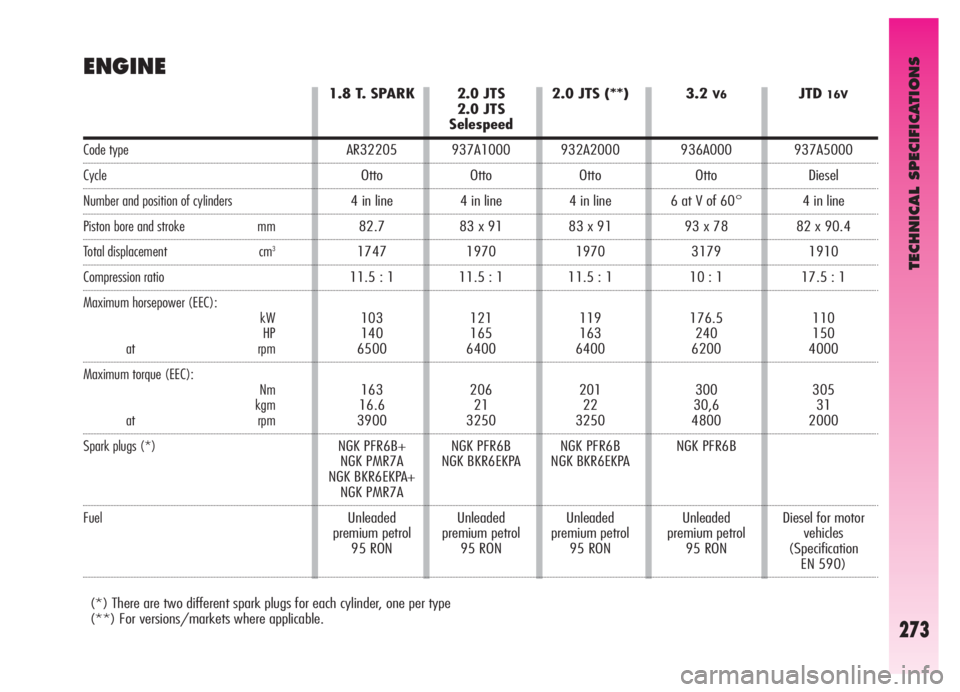ESP Alfa Romeo GT 2005 Owner handbook (in English)
[x] Cancel search | Manufacturer: ALFA ROMEO, Model Year: 2005, Model line: GT, Model: Alfa Romeo GT 2005Pages: 307, PDF Size: 6.05 MB
Page 247 of 307

IN AN EMERGENCY
245
Take care when position-
ing the arms of the lift or
workshop lift to avoid
damaging the side strips.
USING AN ARM LIFT OR
WORKSHOP LIFT
The vehicle should be lifted only at the
side, setting the end of the arms or the
workshop lift in the illustrated areas, at
approx. 40 cm from the wheelhouse pro-
file (fig. 57).These areas are highlighted by the sym-
bol
▼on the lower part of the side mem-
ber.
The car may fall if the
jack is not positioned cor-
rectly. Never use the jack
for higher capacities than the one
stated on the label.
IMPORTANTFor versions with
Selespeed transmission, make sure that
the gears are in neutral (N) (checking
that the vehicle moves if pushed) and
then proceed as for towing a normal car
with mechanical transmission, following
the instructions given previously.
Should it be impossible to set the gears
to neutral, do not tow the car and contact
Alfa Romeo Authorised Services.Do not start the engine
when towing the car.
IF THE VEHICLE IS TO BE LIFTED
fig. 57
A0A0672b
Page 248 of 307

IN AN EMERGENCY
246
other crashes is high. Leave the car imme-
diately and go beyond the guard-rail.
– If doors are blocked, do not try to get
out of the car breaking the windscreen
which is stratified. The windows and rear
screen are easier to break.
– Remove the ignition key of the vehi-
cles involved.
– If you note a smell of fuel or other
chemical products, do not smoke and
have a cigarette stubbed out.
– To put out fires, even small ones, use
the extinguisher, blankets, sand, or earth.
Never use water.
– If use of the lighting system is not nec-
essary, disconnect the battery negative
terminal (–).IN THE EVENT
OF AN ACCIDENT
– It is important to keep calm.
– If you are not directly involved, stop at
least a few dozen metres away from the
accident.
– On motorways, stop without blocking
the emergency lane.
– Turn the engine off and the hazard
warning lights on.
– At night, illuminate the place of the
accident with the headlights.
– Take care, do not risk being run over.
– Signal the accident placing the trian-
gle at regulation distance in a clearly visi-
ble place.
– Call the emergency organisation, giv-
ing the most accurate information possi-
ble. On motorways use the special phones
provided.
– In motorways pileups, especially with
poor visibility, the risk of being involved in
IF PEOPLE ARE INJURED
– An injured person must never be aban-
doned. Helping is compulsory also for per-
sons not directly involved in the accident.
– Do not crowd around injured people.
– Reassure the injured person that help
is on the way, and stay near to overcome
any panic.
– Release or cut the seat belt restraining
injured persons.
– Do not give injured persons anything
to drink.
– An injured person should never be
moved except in the following circum-
stances.
– Remove an injured person from the
car only in danger of fire, sinking or
falling. When removing an injured person:
do not pull the limbs or bend the head and
keep the body as horizontal as possible.
FIRST AID KIT
In addition to the first-aid kit, it is also
wise to keep an extinguisher and a blan-
ket in the car.
Page 250 of 307

VEHICLE MAINTENANCE
248
SCHEDULED MAINTENANCE PROGRAMME
20 40 60 80 100 120 140 160 180Thousands of km
Check tyre conditions/wear and adjust pressure if necessary
Check operation of lighting system (headlights, direction indicators, hazard warning
lights, boot, passenger compartment, glovebox lights, warning lights, etc..)
Check operation of windscreen washer system, adjust spray jets
Check position/wear of windscreen/rearscreen wiper blades
Check operation of front disk brake pad wear indicator
Check wear conditions of rear disk brake pads
Sight check the conditions of: body exterior, underbody protection, stiff pipes
and hoses (exhaust - fuel supply - brakes), rubber parts
(boots - sleeves - bushes etc..)
Check for bonnet and boot lock cleanness, lever cleanness and lubrication
Sight check for accessory drive belt conditions
Check handbrake lever stroke adjustment
Check antievaporation system (petrol versions)
Change air cleaner cartridge (petrol versions)
Change air cleaner cartridge (JTD versions)
Top up fluid levels (engine coolant, brakes, windscreen washer, battery, etc..)
Check and if necessary top up the Selespeed automatic transmission oil level
(2.0 JTS versions)
●●●●●●●●●
●●●●●●●●●
●●●●●●●●●
●●●●●●●●●
●●●●●●●●●
●●●●
●●●●●●●●●
●●●●●●●●●
●●
●●●●
●●
●●●●
●●●●●●●●●
●●●●●●●●●
●●●●●●●●●
Page 254 of 307

VEHICLE MAINTENANCE
252
Vehicle maintenance
should be entrusted to
Alfa Romeo Authorised
Services. For routine and minor
maintenance operations you wish
to carry out yourself, always
make sure you have the proper
equipment, genuine Alfa Romeo
spares and the necessary fluids;
do not however carry out these
operations if you have no experi-
ence.IMPORTANT
Pollen filter
If the vehicle is used frequently in dusty
or heavily polluted environments it is
advisable to replace the filtering element
more frequently; in particular it should be
replaced if a reduction of the amount of
air admitted to the passenger compart-
ment is noted. IMPORTANT
Battery
It is advisable to check the battery
charge, preferably at the onset of winter,
to prevent the possibility of the electrolyte
freezing.
This check should be carried out more
frequently if the car is used mainly for
short trips, or if it is fitted with accessories
that permanently absorb electricity even
with the ignition key removed, especially
in the case of after market accessories.
If the vehicle is used in hot climates or
particularly harsh conditions it is wise to
check the level of the battery fluid (elec-
trolyte) more frequently than specified in
the Scheduled Maintenance Programme.
Page 255 of 307

VEHICLE MAINTENANCE
253
1Engine oil - 2Battery - 3Brake fluid -4
Windscreen/rearscreen/headlamp
washer fluid - 5Engine coolant fluid -
6Power steering fluid - 7Selespeed
transmission oil (2.0 JTS Selespeed ver-
sions)
CHECKING LEVELS
Never smoke while
working in the engine
compartment; gas and
inflammable vapours may be pre-
sent, with the risk of fire.
When topping up take
care not to confuse the
various types of fluids:
they are incompatible with one
another and could seriously dam-
age the vehicle.fig. 1 - 1.8 T. SPARK version
A0A0736b
A0A0681b
fig. 1a - 2.0 JTS version
Page 257 of 307

VEHICLE MAINTENANCE
255
ENGINE OIL (fig. 4-4a-5-6)
The engine oil should be checked with
the vehicle on a level surface a few min-
utes (about 5) after the engine has been
switched off.
Remove the dipstick (A), clean it, put it
back in completely, remove it and check
that the level is within the MINand
MAXmarks on the dipstick. The interval
between the MINandMAXmarks cor-
respond to about one litre of oil.When the engine is hot,
take care when working
inside the engine com-
partment to avoid burns.
Remember that when the engine
is hot, the fan may cut in: danger
of injury.
Do not add oil with spec-
ifications (classification,
viscosity) other than
those of the oil already in the
engine.
fig. 4 - 1.8 T. SPARK version
A0A0737b
fig. 6 - JTD 16Vversion
A0A0398b
AB
fig. 5 - 3.2 V6version
A0A0406b
If the oil level is near or even below the
MINmark, add oil through the filter neck
(B), until reaching the MAXmark.
IMPORTANTIf a routine check
reveals that the level is above the MAX
mark, contact Alfa Romeo Authorised
Services to have the correct level restored.
IMPORTANTAfter topping up the oil,
before checking the level again, run the
engine a few seconds and wait for a few
minutes ater stopping it.
fig. 4a - 2.0 JTS version
A0A0682b
Page 258 of 307

VEHICLE MAINTENANCE
256
Used engine oil and filter
contain harmful sub-
stances for the environ-
ment. Contact Alfa Romeo
Authorised Services to have the
oil and the filter changed, as they
are equipped to dispose of the
waste oil and filters respecting
nature and the law.
SELESPEED TRANSMISSION
OIL
(fig. 7)
The Selespeed transmission oil should be
checked with the vehicle on a level sur-
face and with the engine stopped and
cold.
To check the level, proceed as follows:
– turn the ignition key to MAR;
– disconnect the breather tube and
remove the cap (A) checking that the
level corresponds with the MAXmark on
the dipstick integrated with the cap;
– if the oil is below the MAXmark, top
up to reach the correct level;Do not add oil with spec-
ifications other than that
already in the gearbox.
fig. 7
A0A0197b
Used gearbox oil con-
tains dangerous sub-
stances for the environ-
ment. For changing the oil we
advise contacting Alfa Romeo
Authorised Services who are
equipped for disposing of used oil
respecting nature and the law.
Be very careful working
inside the engine com-
partment if the engine is
hot: danger of burns. Remember
that the fan may cut in if the
engine is very hot: danger of
injury.
Engine oil consumption
Max engine oil consumption is usually
400 grams every 1000 km.
During the initial period of use the
engine settles, therefore engine oil con-
sumption may be considered stabilised
only after the first 5000 ÷ 6000 km.
IMPORTANTEngine oil consumption
depends on the way of driving and the
conditions of use of the vehicle.– after refitting the cap, insert the
breather tube firmly on the housing on the
cap and turn the ignition key to STOP.
Page 263 of 307

VEHICLE MAINTENANCE
261
BATTERY
The battery is of the “Limited
Maintenance” type and is fitted with an
optical indicator (A-fig. 12) for check-
ing the electrolyte level and charge.
Under normal conditions of use the elec-
trolyte does not need topping up with dis-
tilled water. To make sure that it is in effi-
cient conditions, at routine intervals check
the indicator on the battery cover which
should be dark in colour with a green cen-
tral area.
If the indicator is a bright light colour, or
dark without the green central area, con-
tact Alfa Romeo Authorised Services.
fig. 12
A0A0224b
Batteries contain harmful
substances for the envi-
ronment. To change the
battery we advise contacting Alfa
Romeo Authorised Services who
are equipped for disposal respect-
ing nature and the law.
The incorrect installation
of electric accessories
may cause serious dam-
age to the vehicle. If, after buy-
ing the car, you wish to install
accessories (alarm, radio,
radiotelephone, etc.) contact Alfa
Romeo Authorised Services who
will be able to suggest the most
suitable devices and above all
advise about the need to use a
more powerful battery.
If the car is to remain
inactive for a long time in
very cold conditions,
remove the battery and take it to
a warm place, otherwise it may
freeze.
POLLEN FILTER
Have the dust/pollen filter checked once
a year by Alfa Romeo Authorised Services,
preferably at the onset of summer.
If the car is mainly used in dusty or heav-
ily polluted areas, the filter should be
changed at more frequent intervals than
specified in the Scheduled Maintenance
Programme.
IMPORTANTThe failure to replace
the pollen filter can considerably reduce
the effectiveness of the climate control
system.
When working on the
battery or near to it,
always protect the eyes
with goggles.
The liquid contained in
the battery is poisonous
and corrosive. Avoid con-
tact with the skin or eyes. The
battery should be charged in a
well ventilated place away from
naked flames or possible sources
of sparks: danger of explosion
and fire.
Page 274 of 307

TECHNICAL SPECIFICATIONS
272
BODYWORK PAINT
IDENTIFICATION LABEL
The label (fig. 4) is on the inner left edge
of the tailgate. It contains the following in-
formation:
A. Paint manufacturer.
B. Name of colour.
C. Colour code.
D.Indication on the type of product to be
used for touching-up.
ENGINE STAMP
The engine marking is stamped on the
gearbox side of the crankcase, in corre-
spondence with the exhaust manifold.
ENGINE CODES - BODY VERSIONS
fig. 4
A0A0651b
Engine code Body versions
1.8 T. SPARKAR322005 937CXR1A 26
2.0 JTS937A1000 937CXH1A 22
2.0 JTS
932A2000 937CXHT1A 29
(For specific markets)
2.0 JTS Selespeed937A1000 937CXH11 23
3.2V6936A000 937CXP1B 25
JTD16V937A5000 937CXN1B 24B
Page 275 of 307

TECHNICAL SPECIFICATIONS
273
ENGINE
2.0 JTS
2.0 JTS
Selespeed
937A1000
Otto
4 in line
83 x 91
1970
11.5 : 1
121
165
6400
206
21
3250
NGK PFR6B
NGK BKR6EKPA
Unleaded
premium petrol
95 RON2.0 JTS (**)
932A2000
Otto
4 in line
83 x 91
1970
11.5 : 1
119
163
6400
201
22
3250
NGK PFR6B
NGK BKR6EKPA
Unleaded
premium petrol
95 RONJTD16V
937A5000
Diesel
4 in line
82 x 90.4
1910
17.5 : 1
110
150
4000
305
31
2000
Diesel for motor
vehicles
(Specification
EN 590) 3.2
V6
936A000
Otto
6 at V of 60°
93 x 78
3179
10 : 1
176.5
240
6200
300
30,6
4800
NGK PFR6B
Unleaded
premium petrol
95 RON
(*) There are two different spark plugs for each cylinder, one per type
(**) For versions/markets where applicable.1.8 T. SPARK
AR32205
Otto
4 in line
82.7
1747
11.5 : 1
103
140
6500
163
16.6
3900
NGK PFR6B+
NGK PMR7A
NGK BKR6EKPA+
NGK PMR7A
Unleaded
premium petrol
95 RONCode type
Cycle
Number and position of cylinders
Piston bore and stroke mm
Total displacement cm3
Compression ratio
Maximum horsepower (EEC):
kW
HP
at rpm
Maximum torque (EEC):
Nm
kgm
at rpm
Spark plugs (*)
Fuel